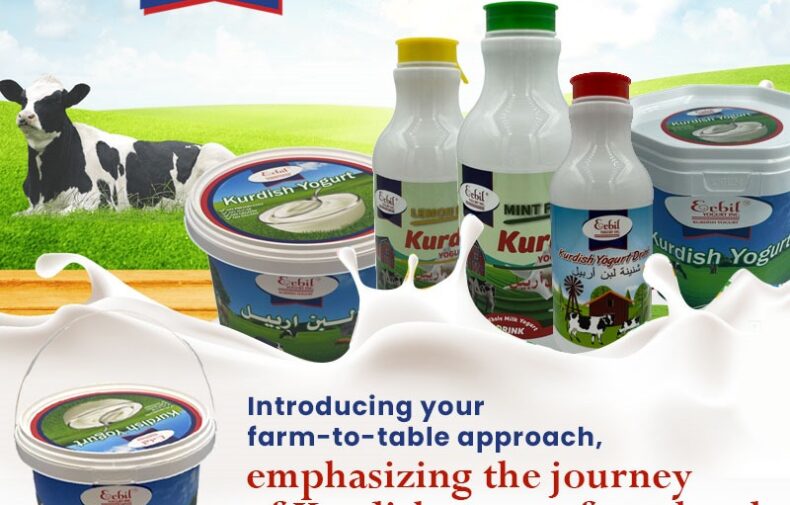Yogurt is a versatile and beloved dairy product that has a special place in the culinary traditions of many cultures around the world. One of the most distinctive and cherished varieties of yogurt is Kurdish yogurt, which hails from the Kurdish regions in the Middle East. Known for its unique flavor, thick consistency, and health benefits, Kurdish yogurt has gained popularity not only in its place of origin but also in international cuisines. In this article, we will explore the rich history, preparation, and culinary uses of Kurdish yogurt.

The Historical Significance
Yogurt’s roots can be traced back thousands of years to the Middle East and Central Asia, where it was discovered quite by accident. The nomadic herders of the region stored milk in animal skins and found that the milk would ferment into a tangy, thick, and creamy substance. Over time, they perfected the art of yogurt-making, and it became a staple in their diets.
Kurdish yogurt, often referred to as “Kurdish lebani,” has been a cherished component of Kurdish cuisine for centuries. The Kurds, a diverse and ancient ethnic group spread across several countries in the Middle East, have perfected the art of yogurt-making, and it has become an integral part of their cultural identity.
The Making of Kurdish Yogurt
Kurdish yogurt is made through a process that combines simplicity with precision. It typically requires just two ingredients: fresh milk and a small amount of yogurt from a previous batch as a starter culture. The key steps in making Kurdish yogurt include:
- Heating the Milk: Fresh milk is gently heated to around 180°F (82°C) to kill any harmful bacteria and to thicken the yogurt.
- Cooling: After heating, the milk is allowed to cool down to a temperature of around 110°F (43°C). This is the ideal temperature for the active cultures in the yogurt starter to thrive.
- Inoculation: A small amount of yogurt from a previous batch is added to the cooled milk to introduce beneficial bacteria, which will ferment the milk into yogurt. This step is crucial as it transfers the unique culture from one batch to the next.
- Fermentation: The milk and starter culture are mixed, covered, and left to ferment for several hours. This process can take anywhere from 4 to 12 hours or more, depending on the desired thickness and flavor.
- Straining (Optional): To achieve the desired thickness, Kurdish yogurt is often strained through a cheesecloth or a special yogurt strainer, which removes excess whey, resulting in a creamy and dense consistency.
Culinary Uses
Kurdish yogurt is renowned for its rich and distinct flavor. It has a tangy taste that is less sour than some other yogurt varieties, making it an excellent ingredient in a wide range of dishes. Here are some popular culinary uses of Kurdish yogurt:
- Dips and Sauces: Kurdish yogurt serves as the base for many dips and sauces, such as tzatziki, a popular Mediterranean sauce made with yogurt, cucumbers, and herbs. It’s also used in various Kurdish sauces to accompany grilled meats or kebabs.
- Desserts: In Kurdish cuisine, yogurt is used to make a variety of sweet treats. One such dessert is “shirin lebani,” where yogurt is sweetened with sugar and flavored with rosewater or saffron.
- Marinades: The thick consistency of Kurdish yogurt makes it an ideal ingredient for marinades. It helps tenderize meats and infuses them with a delightful flavor.
- Soups and Stews: Kurdish yogurt is sometimes added to soups and stews to provide a creamy texture and a subtle tangy flavor.
- Breakfast: Kurdish yogurt is a common choice for breakfast, often paired with honey, nuts, and fruits, providing a nutritious and filling morning meal.
Health Benefits
Kurdish yogurt, like other yogurt varieties, is not only delicious but also packed with health benefits. It’s an excellent source of probiotics, which promote gut health and aid in digestion. Additionally, it’s rich in calcium, protein, and various vitamins and minerals.
Conclusion
Kurdish yogurt, with its rich history, distinctive flavor, and versatility in the kitchen, is a testament to the culinary traditions of the Kurdish people. Whether enjoyed as a savory condiment, a sweet dessert, or a healthy breakfast option, Kurdish yogurt has made its mark on the global food scene. So, the next time you reach for a container of yogurt, consider trying Kurdish yogurt for a unique and flavorful twist on this beloved dairy product.


